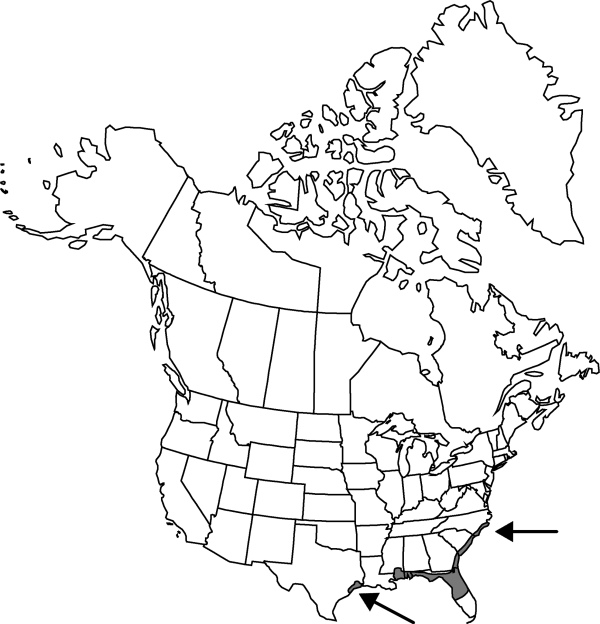Difference between revisions of "Opuntia pusilla"
Syn. Pl. Succ., 195. 1812.
FNA>Volume Importer |
imported>Volume Importer |
||
| (7 intermediate revisions by 2 users not shown) | |||
| Line 8: | Line 8: | ||
}} | }} | ||
|common_names=Sandbur pricklypear | |common_names=Sandbur pricklypear | ||
| − | |basionyms={{Treatment/ID/ | + | |special_status={{Treatment/ID/Special_status |
| + | |code=E | ||
| + | |label=Endemic | ||
| + | }} | ||
| + | |basionyms={{Treatment/ID/Basionym | ||
|name=Cactus pusillus | |name=Cactus pusillus | ||
|authority=Haworth | |authority=Haworth | ||
| + | |rank=species | ||
| + | |publication_title=Misc. Nat., | ||
| + | |publication_place=188. 1803 | ||
}} | }} | ||
|synonyms={{Treatment/ID/Synonym | |synonyms={{Treatment/ID/Synonym | ||
|name=Opuntia drummondii | |name=Opuntia drummondii | ||
|authority=Graham | |authority=Graham | ||
| − | }}{{Treatment/ID/Synonym | + | |rank=species |
| + | }} {{Treatment/ID/Synonym | ||
|name=Opuntia tracyi | |name=Opuntia tracyi | ||
|authority=Britton | |authority=Britton | ||
| + | |rank=species | ||
}} | }} | ||
|hierarchy=Cactaceae;Cactaceae subfam. Opuntioideae;Opuntia;Opuntia pusilla | |hierarchy=Cactaceae;Cactaceae subfam. Opuntioideae;Opuntia;Opuntia pusilla | ||
| Line 26: | Line 35: | ||
}}<!-- | }}<!-- | ||
| − | --><span class="statement" id="st- | + | --><span class="statement" id="st-undefined" data-properties=""><b>Shrubs,</b> creeping, often forming mats, trailing, to 0.1 m. <b>Stem</b> segments easily detached, green, purplish red under stress, flattened, elliptic to linear, sometimes subcylindric (to subspheric), 2.5–5(–8) × 1.2–2.5 cm, tuberculate, glabrous; areoles 2–5 per diagonal row across midstem segment, subcircular, 2–3 mm diam.; wool tan to gray. <b>Spines</b> (0–)1–2(–4) per areole, in distal 3/4 of stem segment areoles (to nearly spineless), porrect to spreading, red-brown, aging gray, stout, straight, terete, to 30 mm, strongly barbed. <b>Glochids</b> in crescent at adaxial edge of areole, pale yellow, aging brown, to 3 mm, longest at areole apex. <b>Flowers</b>: inner tepals yellow throughout, 20–30 mm; filaments and anthers yellow; style and stigma lobes white. <b>Fruits</b> green becoming red-purple at late maturity, barrel-shaped, 18–30 × 12–20 mm, fleshy, glabrous, spineless; areoles 8–16. <b>Seeds</b> tan, subcircular, flattened, 4–6 mm diam.; girdle slightly protruding. <b>2n</b> = 44.</span><!-- |
-->{{Treatment/Body | -->{{Treatment/Body | ||
| + | |phenology=Flowering spring (Apr–May). | ||
|habitat=Dune and pine scrub, primarily coastal, sandy openings, dunes, or rocky outcrops | |habitat=Dune and pine scrub, primarily coastal, sandy openings, dunes, or rocky outcrops | ||
|elevation=0-100 m | |elevation=0-100 m | ||
| Line 40: | Line 50: | ||
-->{{#Taxon: | -->{{#Taxon: | ||
name=Opuntia pusilla | name=Opuntia pusilla | ||
| − | |||
|authority=(Haworth) Haworth | |authority=(Haworth) Haworth | ||
|rank=species | |rank=species | ||
| Line 47: | Line 56: | ||
|basionyms=Cactus pusillus | |basionyms=Cactus pusillus | ||
|family=Cactaceae | |family=Cactaceae | ||
| + | |phenology=Flowering spring (Apr–May). | ||
|habitat=Dune and pine scrub, primarily coastal, sandy openings, dunes, or rocky outcrops | |habitat=Dune and pine scrub, primarily coastal, sandy openings, dunes, or rocky outcrops | ||
|elevation=0-100 m | |elevation=0-100 m | ||
| Line 53: | Line 63: | ||
|publication title=Syn. Pl. Succ., | |publication title=Syn. Pl. Succ., | ||
|publication year=1812 | |publication year=1812 | ||
| − | |special status= | + | |special status=Endemic |
| − | |source xml=https:// | + | |source xml=https://bitbucket.org/aafc-mbb/fna-data-curation/src/2e0870ddd59836b60bcf96646a41e87ea5a5943a/coarse_grained_fna_xml/V4/V4_239.xml |
|subfamily=Cactaceae subfam. Opuntioideae | |subfamily=Cactaceae subfam. Opuntioideae | ||
|genus=Opuntia | |genus=Opuntia | ||
|species=Opuntia pusilla | |species=Opuntia pusilla | ||
| − | |||
| − | |||
| − | |||
| − | |||
| − | |||
| − | |||
| − | |||
| − | |||
| − | |||
| − | |||
| − | |||
| − | |||
| − | |||
| − | |||
| − | |||
| − | |||
| − | |||
| − | |||
| − | |||
| − | |||
| − | |||
| − | |||
| − | |||
| − | |||
| − | |||
| − | |||
| − | |||
| − | |||
| − | |||
| − | |||
| − | |||
| − | |||
| − | |||
| − | |||
| − | |||
| − | |||
| − | |||
| − | |||
| − | |||
| − | |||
| − | |||
| − | |||
| − | |||
| − | |||
| − | |||
| − | |||
| − | |||
| − | |||
}}<!-- | }}<!-- | ||
-->[[Category:Treatment]][[Category:Opuntia]] | -->[[Category:Treatment]][[Category:Opuntia]] | ||
Latest revision as of 21:57, 5 November 2020
Shrubs, creeping, often forming mats, trailing, to 0.1 m. Stem segments easily detached, green, purplish red under stress, flattened, elliptic to linear, sometimes subcylindric (to subspheric), 2.5–5(–8) × 1.2–2.5 cm, tuberculate, glabrous; areoles 2–5 per diagonal row across midstem segment, subcircular, 2–3 mm diam.; wool tan to gray. Spines (0–)1–2(–4) per areole, in distal 3/4 of stem segment areoles (to nearly spineless), porrect to spreading, red-brown, aging gray, stout, straight, terete, to 30 mm, strongly barbed. Glochids in crescent at adaxial edge of areole, pale yellow, aging brown, to 3 mm, longest at areole apex. Flowers: inner tepals yellow throughout, 20–30 mm; filaments and anthers yellow; style and stigma lobes white. Fruits green becoming red-purple at late maturity, barrel-shaped, 18–30 × 12–20 mm, fleshy, glabrous, spineless; areoles 8–16. Seeds tan, subcircular, flattened, 4–6 mm diam.; girdle slightly protruding. 2n = 44.
Phenology: Flowering spring (Apr–May).
Habitat: Dune and pine scrub, primarily coastal, sandy openings, dunes, or rocky outcrops
Elevation: 0-100 m
Distribution

Ala., Fla., Ga., Miss., N.C., S.C., Tex.
Discussion
Selected References
None.